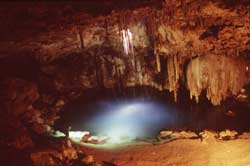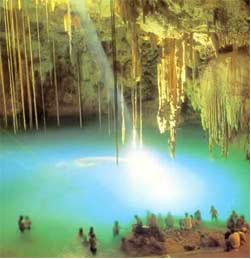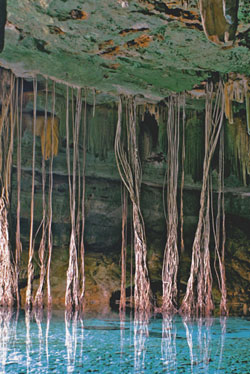Caves-
Popular caves include; Lultun, Calcehtok, Balankanche and Tzabnah.
Cenotes
(Courtesy Yucatan
Today.com)
The natural wonders of the state of Yucatan are
innumerable and some of the most important and unusual are the cenotes
(say-NOH-tays) or sink holes. In the Yucatan there are over 3000 cenotes,
with only 1400 actually studied and registered.
The Maya called them dzonot (ZO-note), which the
conquering Spaniards translated as cenote (say– NO–tay.) Giraldo Diaz Alpuche,
was a military commander in the 16th Century who was greatly impressed
with these underground caverns and pools, and he tried to explain the meaning
of the word cenote in the Spanish language as meaning "deep thing". The
Motul dictionary, a
dictionary of Mayan hieroglyphics, defines dzonot as "abysmal and deep".
Cenotes are magical, enigmatic and unique in the
world and were once the only resource for fresh, sweet water in the local
Yucatecan jungle. They were the sacred places of the Maya for that reason,
but also because they represented the entrance to the underworld.
The Yucatan Peninsula is a porous limestone shelf
with no visible rivers; all the fresh water rivers are underground. Being
porous, caverns and caves formed where the fresh water collects – hence
the cenotes or water sink holes. The water that gathers in these subterranean
cenotes is a crystal clear turquoise color with a very pleasant temperature
of 78°'b0.
The stalactites and stalagmites that form inside
the cenotes are true natural works of art. In many, holes in the ceiling
allow the sunlight to filter into the cenotes, giving the scene a magical
feeling. The cenotes of Yucatan are a natural treasure that should be seen
by all, keeping in mind that they should be protected so that man does
not destroy in a few days what nature took millions of years to create.
There are four different types of cenotes - those
that are completely underground, those that are semi-underground, those
that are at land level like a lake or pond, like the one at Dzibilchaltun
and those that are open wells, like the one in Chichen
Itza. Some of them are accessible for swimming and cave diving, but
this is a sport that should ONLY be practiced with a professional guide.
CUZAMA CENOTES
The town of Cuzamá is becoming well known
for the large number of cenotes found there. Especially unique is a tour
that you can do in this area where you will visit three cenotes. If you
go to the hacienda in Cuzama, you can hire a guide who will put you on
a platform buggy pulled by horses. You will travel this way for 4.5 miles
on interesting paths through the surrounding countryside. The main cenotes
are: Chelentun (laying down rock), Chansinic'che (tree with small ants)
and Bolonchoojol (nine drops of water). The Chelentun Cenote is located
about 1.8 miles from the Chunkanan hacienda and about 1.8 miles south of
Cuzama. The water is incredibly blue and clear with excellent visibility.
Stalagtite and stalagmite formations add to its unique beauty. For more
information, check out our Cuzamá
daytrip.
CENOTE ZACI
Located in the heart of Valladolid,
this is a semi-open cenote that has a diameter of 150 feet and is 260 feet
deep. This is a popular cenote for swimming in the refreshing turquoise
waters. You will see a rare species of eyeless black fish known as "lub."
A third of the cenote is covered with stalagtites and stalagmites and there
is a walkway around the entire cenote. There is also a great restaurant
on the property.

Above: Another view of Dzitnup Cenote.
CENOTE DZINUP OR KEKEN
Located 4.3 miles southeast of Valladolid, this
cenote is underground with a hole in the ceiling. It is probably one of
the most photographed cenotes in the Yucatan. Deep, refreshing, crystal
clear waters await you and it is a great cenote for swimming. There is
lighting and a guide rope to make it easier to enter. Don´t forget
to buy a picture postcard from the kids at the entrance as taking a picture
just never turns out right and you WILL want a picture of this to show
the family.

Above: Dzitnup Cenote near Valladolid in the Yucatan.
CENOTE IK KIL
Located in the Eco-archeological Park Ik Kil,
just 1.8 miles from Chichen
Itza and Pista. Called the "Sacred Blue Cenote," it is a perfectly
round well-type cenote with exuberant vegetation and waterfalls. This is
another ideal place for swimming in the clear blue water. 196 feet wide
and about 130 feet deep, it is an open cenote about 85 feet from the surface.
A grand stairway leads you down the steps into the water.
Entrance is 35 pesos and it is open daily from
8 AM to 6 PM. There is also an excellent buffet style restaurant here and
bungalows for overnight stay.
CENOTILLO
This village gets its name from the large number
of cenotes located within the town and the outskirts. According to locals
there are more that 150 cenotes, some of which are located in open fields.
It is necessary to ask a local to take you. The main ones are Kaipech,
Xayin and Ucil.
CENOTE XCALAH
Located at the Mayan site of Dziblichaltun,
just north of Merida, this is the closest to Merida.
Meaning "old village," it is an open ground level cenote, great for swimming.
It is more than 140 feet deep at one end.
Open from 8 AM to 4 PM, it is a great place to
jump in after a visit to the ruins.
If you are interested in diving cenotes, here
are websites with some good information on local cenotes for diving.
http://www.mexicocavediving.com
http://www.gocenotes.com

KANKIRIXCHE CENOTE (tree with yellow fruit)
At Kankirixche Cenote, you will find a large,
spectacular sub-aquatic cavern with crystal clear water that allows fantastic
visibility for snorkeling or scuba. In this grand cenote you will also
find stalagtites and alamo tree roots that form an impressive formation
from the ceiling to the water. Kankirixche is a semi-open cenote 33 feet
high, 90 feet long and about 75 feet wide.
Call Cima & Sima to arrange trips. Tel: 999-987-3710.

Information Courtesy of Yucatan
Today |

